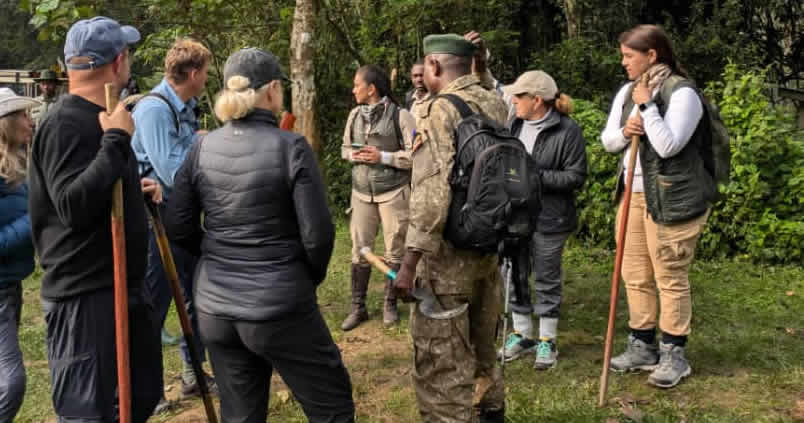Spending one hour with mountain gorillas in the jungles forests of Uganda, Rwanda and Congo is one of the most exciting wildlife adventures that wildlife enthusiasts can engage in during their trips to Africa. Mountain gorillas are rare apes that can only be found in the mountainous jungles east Africa in the Bwindi Impenetrable National Park and the Mgahinga National Park of Uganda, in the Virunga National Park and the Kahuzi Biega reserve of the Democratic Republic of Congo and lastly at the Volcanoes National Park of Rwanda.
The beauty of visiting any of the three countries that offer mountain gorilla tourism is that although the actual gorilla trekking and habituation experiences are similar, there are lots of other exciting tourism features and activities that are unique to each gorilla destination, for example visiting Rwanda’s gorillas offers travelers the out of the ordinary experience of hiking the beautiful 5 volcanoes mountains and of course hiking to visit the grave of Dian Fossey, a zoologist remembered for her great efforts towards the protection and conservation of mountain gorillas.
Visiting Uganda’s mountain gorillas at either Bwindi impenetrable forests or Mgahinga National Park offers visitors the opportunity to visit the Batwa people who were once the original inhabitants of the dense Bwindi Impenetrable forests before it was gazetted as a national park and thereafter having the people relocated to the outskirts of the gorilla park. Visiting the Democratic Republic of Congo to view the mountain gorillas of Virunga National Park also allows travelers the opportunity to visit the Kahuzi Biega reserve to view the rare eastern lowland gorillas which are also endemic to east Africa. Mountain gorillas were in the past decades running extinct because of factors like habitat loss, severe poaching, disease outbreaks and civil wars but currently the gorilla world population has greatly increased to over 1,063 individuals thereby rendering them an endangered species and no longer highly endangered as it was in the past years, all thanks to the massive conservation efforts and campaigns done by governments, non government organizations, surrounding communities and above all travelers whose gorilla trekking activities have greatly supported mountain gorilla conservation activities.
Bwindi Impenetrable National Park is currently home to the largest numbers of mountain gorillas with a half of the population protected and conserved in the gorilla park while the other half of the population has been distributed in the other gorilla parks within the region. The mountain gorillas of Bwindi Impenetrable forests are grouped into 19 habituated families that can be viewed from any of the 4 sectors of the park which include Nkuringo, Rushaga, Ruhija and Buhoma. The Mgahinga National Park which is also located in Uganda is home to 2 habituated gorilla families of Hirwa and Nyakagezi. Rwanda’s gorillas can be viewed from the Volcanoes National Park from which 15 habituated families can be visited, finally the Democratic Republic of Congo’s Virunga National Park boasts of 8 mountain gorilla habituated families while its’ Kahuzi Biega reserve boasts of about 5 eastern low land habituated gorilla families respectively.
All about gorilla trekking in Africa
Trekking down mountain gorillas in the wild jungles of east Africa’s gorilla habitats is a strenuous yet exciting adventure which can last between 30 minutes to 6 hours depending on the gorilla movements and most especially the trekkers fitness levels, upon that background, gorilla trekking is only recommended for travelers aged 15 years old and above as younger children may find the activity too complex for them in addition to being unable to strictly adhere to safety precautions while hiking.
This also explains why gorilla permits are only sold to travelers aged 15 years old and beyond. To participate in gorilla tourism, travelers are required to purchase their gorilla trekking permits which cost 800 USD in Uganda, 1,500 USD in Rwanda and 400 USD in Democratic Republic of Congo. Gorilla habituation permits on the other hand cost 1,500 USD in Uganda. Gorilla permits are usually on very high demand thereby requiring that travelers book theirs between 3-6 months ahead of their expected travel date. These permits can be obtained directly through Uganda Wildlife Authority or Rwanda Development Board although most travelers prefer to obtain theirs through their trusted travel operators.
Upon finding a gorilla family, travelers are allowed strictly one hour to spend quality time with the gorillas, take photographs and watch them go about their daily schedules. Travelers who desire to spend more than one hour with the gorillas can sign up for the gorilla habituation experience where they are allowed up to 4 hours. The Gorilla habituation experience is all about training wild mountain gorillas to accommodate frequent human interactions. This process of habituating wild gorillas is a lengthy process that can take up to 2-3 years with a few exceptions of some gorillas completing the process in just 15 months. During this habituation experience, travelers join gorilla experts and scientists in the wild to offer their assistance in a number of activities like monitoring gorilla health conditions, conducting gorilla census, naming of gorillas, studying their behavior patterns among other activities.
Why does gorilla trekking last 1 hours
- To conserve the endangered mountain gorillas: Gorillas being wild animals prefer to live their lives peacefully and unbothered in their natural habitats. This makes them perceive too much exposure to humans as a threat thereby prompting them to become aggitated, distressed and uncomfortable often leading them to attack their supposed offenders. This behaviour in the mountain gorillas has encouraged the respective park authorities to respect their much needed space and freedom by limiting human-gorilla interactions to only one hour upon locating them and also limiting the number of visitors to only 8 per day.
- To protect gorilla health: Gorillas have a DNA composition that match that of humans by almost 98%, this therefore makes them very prone to catching human diseases like cough, flue and other communicable diseases. Study indicates that one of the greatest causes of deaths among mountain gorillas is the transmission of human borne pathogens when they get exposed to it, whereby a common non -fatal flue in human beings turning out as a fatal condition among the primates. This has therefore encouraged park authorities to restrict the time spent with the primates to one hour in addition to setting a rule that visitors mantain a distance of atleast 7m away from the gorillas upon meeting them.
- To avoid interrupting their daily schedules: Mountain gorillas are very busy primates whose schedules start as early as 6am. They spend their day doing a number of activities like feeding, grooming infants, taking naps, building their nests to spend the night in, playing and socializing with others especially the youngsters among lots of several other activities. In a bid to respect their much needed time to go about their regular schedules, a time limit of one hour to spend quality time with them had to be set by the park authorities.
Other ways to protect Mountain Gorillas
In addition to the reasons for spending an hour with gorillas, other ways to protect the endangered mountain gorillas while visiting them include refraining from touching the gorillas and keeping a distance of about 7m away upon locating them, so as to protect them from catching human disease, Cancelling your trekking mission incase of feeling sick before the trekking date and thereafter rescheduling it when you feel well. This also helps to protect the gorillas from catching human diseases, not throwing any trash in the habitats of the gorillas as they could get into contact with disease causing germs, maintaining a low voice tone while in the forests to prevent the gorillas from misinterpreting the sounds they hear and digging a pit of at least 30cm when in need of using the toilet and thereafter cover the pit well.
Packing List for Gorilla trekking
Given the fact that trekking the mountain gorillas involves hiking through dense vegetation, it’s important to pack outfits that shall protect you from branch scratches, therefore long trousers and long sleeved shirts in neutral colors are the right clothes to pack. Also pack a hat, rain coat, warm hand gloves, warm socks, a sweater, strong sturdy hiking boots, insect repellant cream, back pack, energy drinks, a camera and binoculars.



